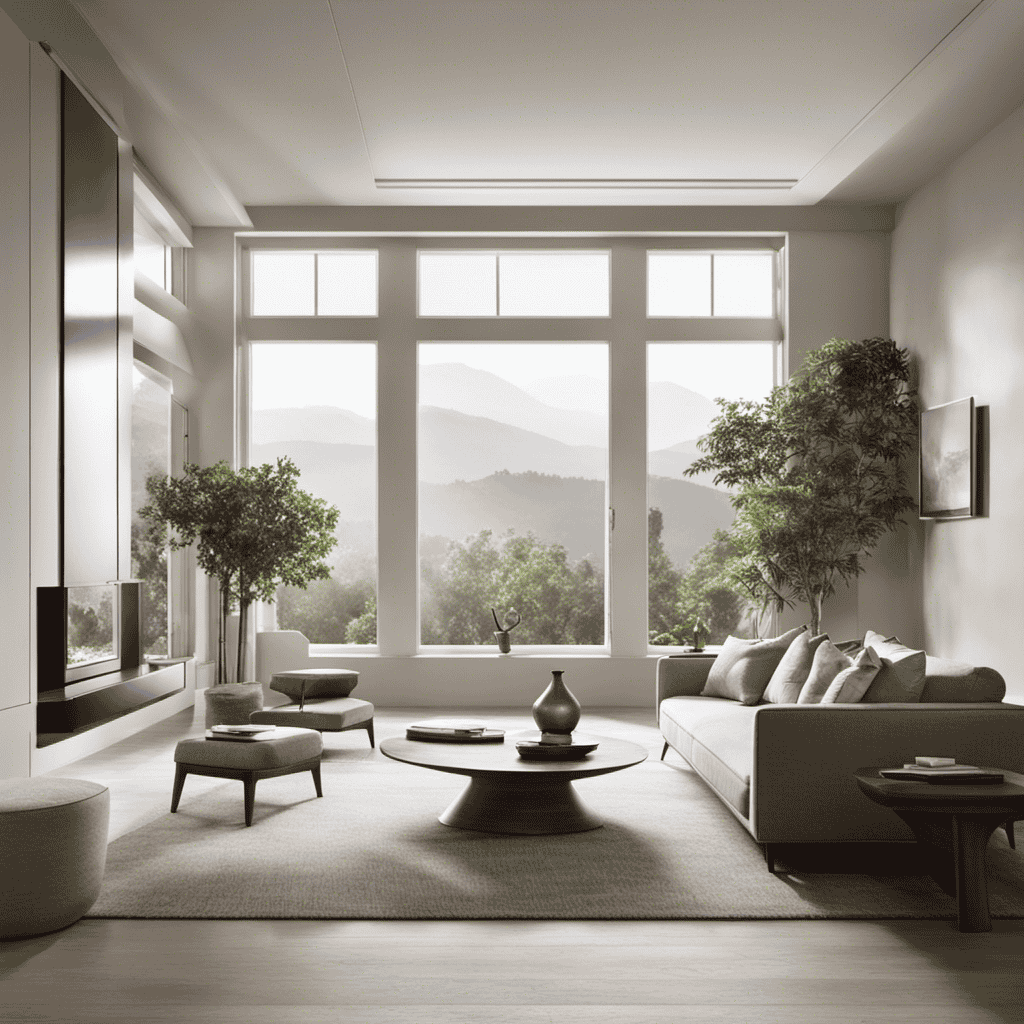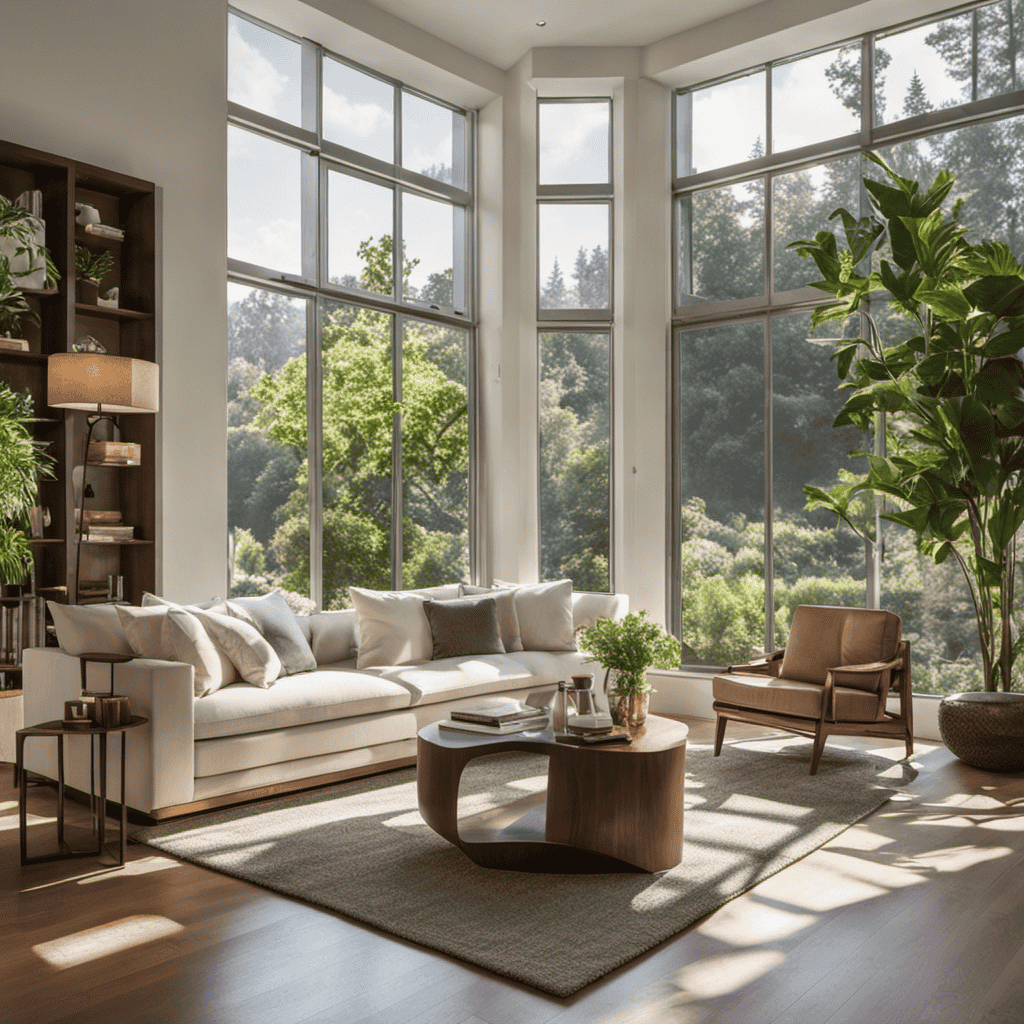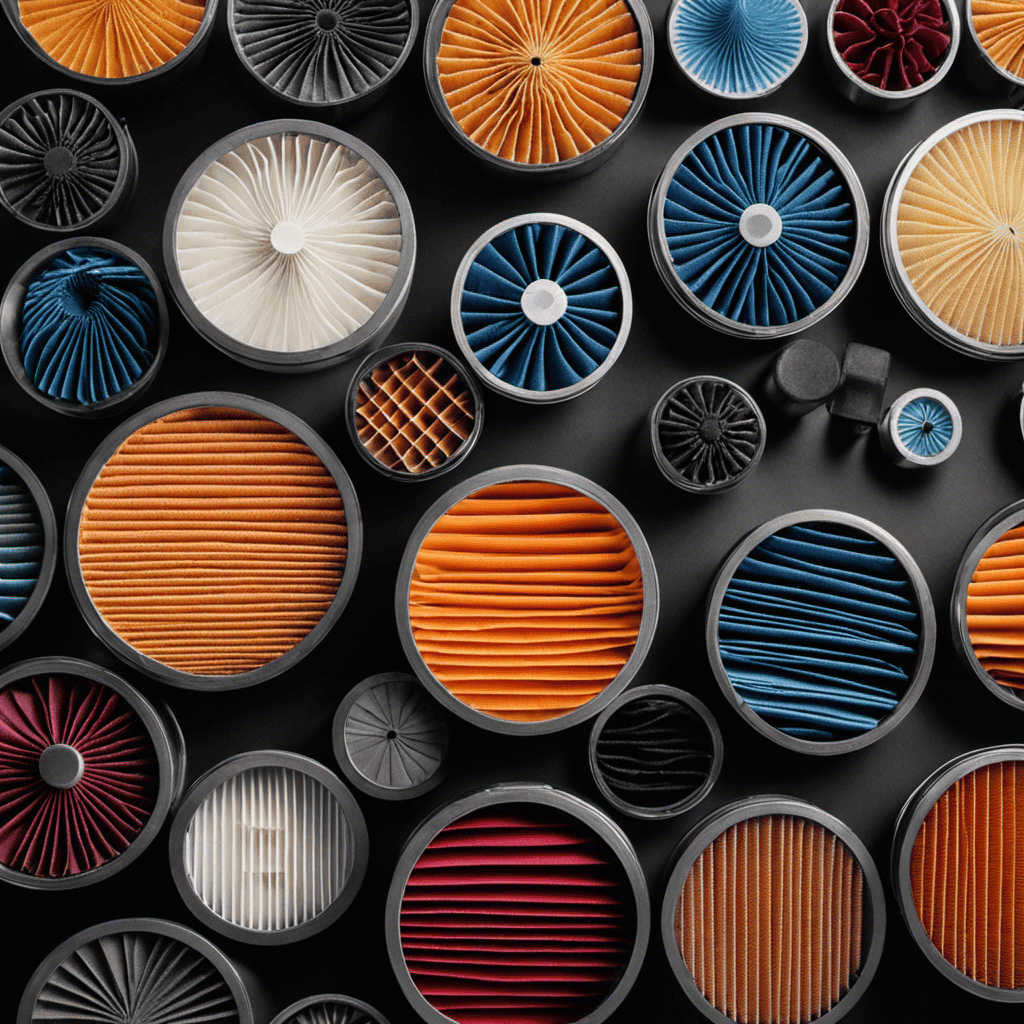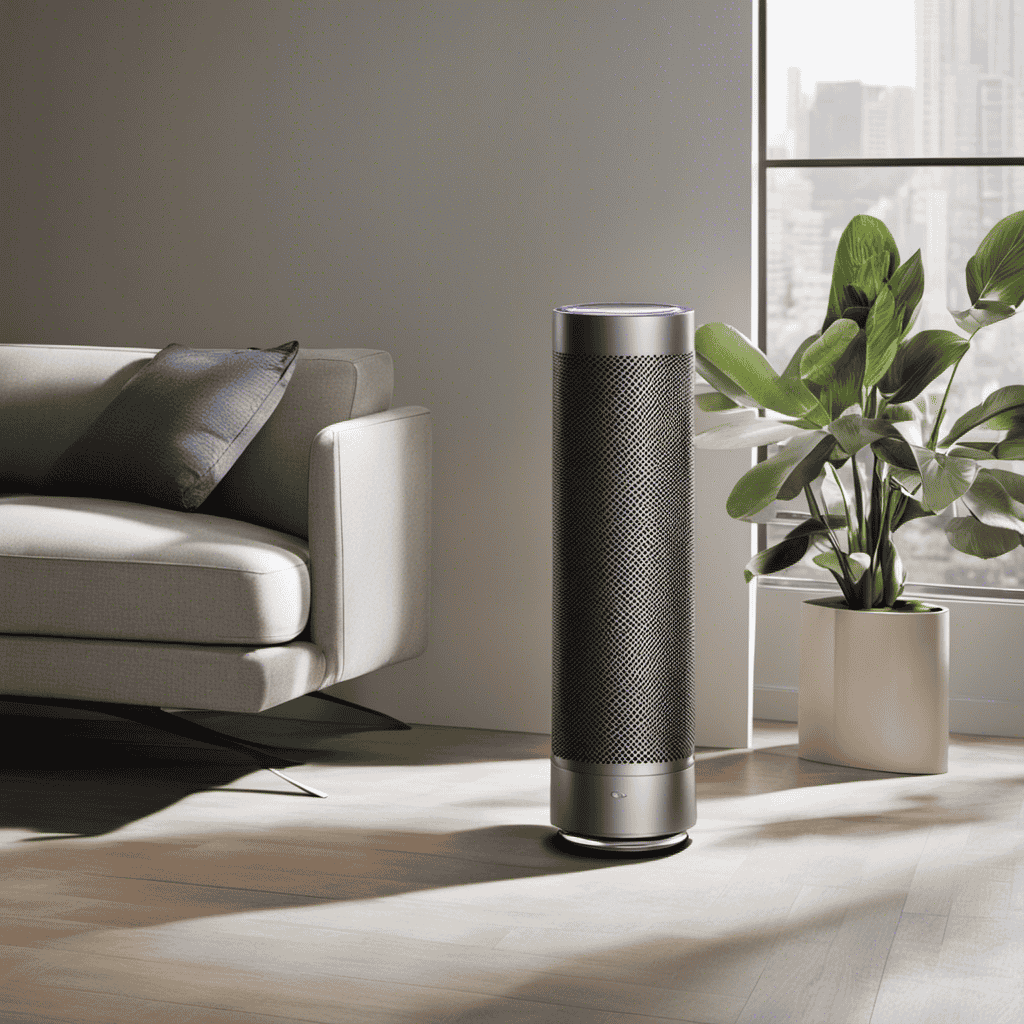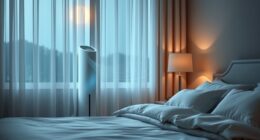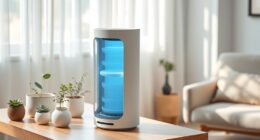As a person who is worried about the air quality in my home, I frequently ask myself, ‘How frequently should I operate my air purifier?’ It’s a common inquiry that many of us think about, and the solution is not always straightforward.
In this article, I will dive into the importance of regular air purifier use, factors to consider when determining usage frequency, and the recommended running time for air purifiers.
By the end, you’ll have a better understanding of how often you should run your air purifier to ensure clean and healthy air in your living space.
Key Takeaways
- Regular air purifier use is important for maintaining clean and healthy indoor air quality.
- Factors such as room size, air pollution levels, and specific needs of occupants should be considered when determining usage frequency.
- Experts recommend running air purifiers for at least 6 to 8 hours a day to maintain optimal air quality.
- Running an air purifier continuously has benefits such as improving indoor air quality, reducing the spread of airborne illnesses, and creating a healthier living environment.
Importance of Regular Air Purifier Use
Regular air purifier use is essential for maintaining clean and healthy indoor air quality. By using an air purifier consistently, you can maximize the air quality in your home and reap the long-term health benefits associated with it.
Research has shown that indoor air can be more polluted than outdoor air, due to various factors such as dust, pet dander, mold, and volatile organic compounds (VOCs) emitted by household products. These pollutants can trigger allergies, asthma, and other respiratory issues, making it crucial to take steps to improve indoor air quality.
An air purifier works by filtering out these harmful particles and contaminants, effectively reducing their presence in the air you breathe. It captures and traps allergens, such as pollen and dust mites, as well as bacteria and viruses. This not only provides immediate relief for individuals with allergies or respiratory conditions but also offers long-term health benefits by reducing exposure to these harmful substances.
Using an air purifier regularly ensures that the air in your home remains clean and healthy on a continuous basis. It is recommended to run your air purifier for several hours a day, especially in high-traffic areas or rooms where you spend the most time. This will help maintain optimal air quality throughout your home, protecting your health and well-being in the long run.
Factors to Consider When Determining Usage Frequency
One factor to consider when deciding how frequently to use an air purifier is the size of the room. The size of the room directly impacts the effectiveness of the air purifier in improving indoor air quality. Larger rooms may require more frequent use of the air purifier to ensure that all the air is properly filtered. On the other hand, smaller rooms may not need the air purifier to run as often.
In addition to room size, other factors to consider include the level of air pollution in the area and the specific needs of the occupants. If you live in an area with high levels of air pollution, it may be necessary to run the air purifier more frequently to combat the pollutants. Similarly, if you or any of your family members suffer from allergies or asthma, it may be beneficial to run the air purifier more often to reduce the presence of allergens and improve air quality.
Ultimately, the impact of air quality on your health and well-being should be the primary factor in determining how frequently to use an air purifier. Regular use can help remove airborne pollutants, allergens, and irritants, creating a cleaner and healthier environment for you and your family.
Recommended Running Time for Air Purifiers
The recommended running time for air purifiers depends on various factors, such as room size, air pollution levels, and the occupants’ specific needs. It’s important to find the right balance between efficiency and energy consumption. Generally, experts suggest running air purifiers for at least 6 to 8 hours a day to maintain optimal air quality. However, this duration can vary depending on the size of the room and the severity of air pollution. For smaller rooms or areas with less pollution, running the air purifier for a shorter duration may be sufficient.
To determine the best times to use air purifiers, consider peak pollution hours in your area. For instance, if the pollution levels are higher during the morning or evening hours, it would be beneficial to run the air purifier during those times. Additionally, running the air purifier while sleeping can help ensure clean air throughout the night, promoting better sleep and overall health.
In conclusion, the recommended running duration for air purifiers depends on several factors, including room size, pollution levels, and personal needs. It is generally advised to run the air purifier for 6 to 8 hours a day, adjusting the duration based on the specific circumstances.
Now, let’s explore the benefits of running an air purifier continuously.
Benefits of Running an Air Purifier Continuously
Running an air purifier continuously can significantly improve indoor air quality and reduce the presence of allergens, pollutants, and other harmful particles. The benefits of continuous usage go beyond simply removing these particles from the air. When an air purifier is run constantly, it ensures that the air in your home remains clean and fresh at all times. This can be particularly beneficial for individuals who suffer from allergies or respiratory conditions, as it helps to create a healthier living environment.
One of the main advantages of running an air purifier continuously is that it helps to maintain consistent air quality. By continuously filtering the air, the purifier can effectively remove allergens and pollutants before they have a chance to accumulate. This can reduce the likelihood of allergy symptoms and respiratory issues, such as coughing or wheezing.
Moreover, running an air purifier continuously can also help to reduce the spread of airborne illnesses. The purifier captures and eliminates bacteria and viruses, preventing them from circulating throughout your home and potentially infecting others.
To demonstrate the benefits of continuous air purifier usage, here is a table that highlights the improvements in air quality achieved by running an air purifier continuously:
| Air Quality | Before Continuous Usage | After Continuous Usage |
|---|---|---|
| Allergens | High | Low |
| Pollutants | Moderate | Low |
| Harmful Particles | High | Low |
| Air Freshness | Stale | Fresh |
| Respiratory Issues | Frequent | Reduced |
How Often to Change Air Purifier Filters
Changing air purifier filters regularly is important for maintaining optimal performance and ensuring that the purifier continues to effectively remove allergens and pollutants from the air. The frequency at which you should change your air purifier filters can vary depending on several factors, such as the type of filter, the level of pollutants in your home, and the manufacturer’s recommendations. However, on average, it is recommended to change the filters every 3 to 6 months.
To determine if your air purifier filters need to be replaced, you can visually inspect them for dirt and debris buildup. Additionally, some air purifiers have indicator lights that will alert you when the filters need to be changed. It is important to follow the manufacturer’s instructions on how to properly replace the filters to ensure that the purifier continues to work effectively.
In order to prolong the lifespan of your air purifier filters and maintain their performance, regular cleaning is also necessary. Here are a few steps to clean your air purifier:
- Turn off and unplug the air purifier.
- Remove the filters according to the manufacturer’s instructions.
- Use a vacuum cleaner with a brush attachment to gently remove any dust and debris from the filters.
- If the filters are washable, rinse them with water and let them air dry completely before reinstalling.
- Reinstall the filters and plug in the air purifier.
Signs That Indicate the Need for Increased Air Purifier Use
To determine if it’s time to use your air purifier more frequently, pay attention to the presence of allergens and pollutants in your home environment. Increased allergies and higher air pollution levels are clear indicators that you should consider running your air purifier more often. Allergens such as pollen, dust mites, and pet dander can cause allergic reactions, leading to symptoms like sneezing, coughing, and itchy eyes. Air pollution, which includes harmful particles, gases, and chemicals, can have detrimental effects on your health, especially if you have pre-existing respiratory conditions.
To help you understand the importance of using your air purifier more frequently, here’s a table highlighting the common allergens and pollutants found in indoor environments:
| Allergens | Pollutants |
|---|---|
| Pollen | Dust particles |
| Dust mites | Volatile organic compounds (VOCs) |
| Pet dander | Mold spores |
By monitoring the presence of these allergens and pollutants, you can make an informed decision about when to increase the usage of your air purifier. Additionally, keep an eye on your allergy symptoms and any changes in air quality to guide your decision-making process.
In the next section, we will discuss tips for maximizing the effectiveness of air purifiers and ensuring that you get the most out of your device.
Tips for Maximizing the Effectiveness of Air Purifiers
If you want to get the most out of your air purifier, try adjusting the placement of the device in different areas of your home. Maximizing air purifier effectiveness requires strategic positioning to ensure optimal airflow and coverage.
Here are some best practices for air purification:
-
Place the air purifier in the center of the room: This allows for better circulation and ensures that the purifier can effectively capture pollutants from all directions.
-
Avoid blocking the air intake and outlet: Make sure there is enough space around the purifier for proper airflow. Blocked vents can hinder the purifier’s performance and reduce its effectiveness.
-
Consider multiple units for larger spaces: If you have a large living area or multiple rooms, it may be beneficial to have multiple air purifiers strategically placed throughout your home. This helps to ensure that every area is effectively purified.
By following these tips, you can maximize the effectiveness of your air purifier and enjoy cleaner air in your home.
However, there are also common mistakes to avoid when running an air purifier, which I will discuss in the next section.
Common Mistakes to Avoid When Running an Air Purifier
One common mistake people make is placing the air purifier too close to walls or furniture, which can obstruct airflow and decrease its effectiveness. When positioning your air purifier, it is crucial to leave a few feet of space between the unit and any obstacles. This allows for proper air circulation and ensures maximum purification.
Another common mistake is neglecting to clean or replace the filters regularly. Over time, filters can become clogged with pollutants, reducing their ability to capture airborne particles. It is recommended to clean or replace the filters as per the manufacturer’s instructions to maintain optimal performance.
Additionally, some people tend to run their air purifiers on the lowest fan speed to reduce noise. However, this can compromise the efficiency of the unit. It is advisable to run the air purifier on a higher fan speed to ensure efficient air cleaning.
Lastly, a common mistake is expecting immediate results. Air purifiers work continuously to remove pollutants, but it may take some time to see noticeable improvements in air quality. Patience is key when using an air purifier.
Is There a Specific Schedule for Running an Air Purifier?
The frequency of running air purifier depends on various factors such as air quality, allergies, and the size of the space. For optimal results, it is recommended to run the air purifier continuously in highly polluted areas, while in less polluted areas, running it for a few hours daily can suffice.
Frequently Asked Questions
Can an Air Purifier Eliminate All Types of Indoor Air Pollutants?
An air purifier can be effective in reducing cigarette smoke and eliminating household odors. However, it is important to note that not all air purifiers are created equal, and their effectiveness can vary depending on the specific model and the pollutants present in the indoor environment.
It is advisable to choose an air purifier that is designed to target the specific pollutants you are concerned about. Regularly running the air purifier can help maintain clean and fresh indoor air quality.
Is It Safe to Run an Air Purifier All Night While Sleeping?
It is safe to run an air purifier all night while sleeping as long as it is properly maintained. Regular air purifier maintenance, such as cleaning or replacing filters, ensures optimal performance and keeps the air quality in your home at its best.
To choose the right air purifier for your needs, consider factors like room size, the type of pollutants you want to remove, and the purifier’s CADR rating.
Are There Any Health Risks Associated With Using an Air Purifier?
There are potential pros and cons to using an air purifier for extended periods. While they can help remove allergens and improve indoor air quality, there is a possibility that constant exposure to purified air may cause respiratory issues for some individuals.
It’s essential to strike a balance and not overly rely on air purifiers. Consulting with a healthcare professional and following manufacturer’s guidelines can help ensure the safe and effective use of air purifiers.
Can Running an Air Purifier Too Often Have Any Negative Effects?
Running an air purifier for long durations may have potential drawbacks. Continuous usage can lead to increased energy consumption and higher costs. It is important to consider the impact on your electricity bill.
Additionally, running the purifier constantly may not be necessary if the air quality in your home is already relatively good. It is recommended to use the air purifier when needed, such as during times of high pollution or when you notice a decrease in air quality.
Are There Any Specific Types of Air Purifiers Recommended for People With Allergies or Asthma?
As someone with allergies, finding the right air purifier is key.
There are several recommended options for people with allergies or asthma. HEPA air purifiers are highly effective at removing allergens from the air. They use a special filter that can trap even the tiniest particles.
Another option is an activated carbon air purifier, which can help eliminate odors and chemicals that can trigger allergies.
It’s important to consider the specific needs of your allergies or asthma when choosing an air purifier.
Conclusion
In conclusion, I have found through thorough research that regular use of an air purifier is essential for maintaining clean and healthy indoor air.
Factors such as the size of the room, the air quality, and the specific needs of individuals should be considered when determining the frequency of usage.
Running an air purifier continuously has numerous benefits, including reducing allergens and pollutants in the air.
It is important to regularly change the filters to ensure optimal performance.
By following these guidelines and avoiding common mistakes, you can maximize the effectiveness of your air purifier and improve the quality of your indoor air.
